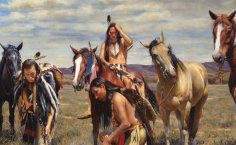
The indigenous people of the United States are Native Americans. Science cannot yet determine with certainty how their tribes arrived in America. However, it is believed that before the Bering Strait existed, people from Siberia crossed a narrow land bridge to Alaska, and then moved deeper into the plains.
In particular, it has been proven that this is how the Navajo Indians came to the United States (in the modern sense of the word) from Alaska and northern Canada. This people is the most numerous among the American Indian peoples. There are over 300,000 Navajo Indians. But they all live on a reservation surrounded on all sides by Hopi tribes, who are hostile to the Navajo.
The situation is very convenient for the US government, allowing it to keep the Navajo Nation on the reservation. The fact is that they have managed to preserve (albeit in a greatly diminished form) the remnants of their independence and are demanding broader rights from the US Congress. Congress occasionally discusses this issue, but fails to pass decisions beneficial to the Navajo Nation.
Incidentally, the conquerors didn't quite give the tribe the right name. They simply mistranslated the word “enemies” (from another Native American language). The resulting name was “Navajo.” Although, in fact, the enemies of the local population were the colonizers themselves.
Over the course of several centuries, the Navajo have learned a great deal—they've mastered agriculture and herding, transitioning from a nomadic life to a settled one. But at the same time, they've developed a strong aversion to tourists visiting the reservation. This sometimes leads to humorous incidents. This is precisely the kind of incident we'll discuss below. It's a true story, and it's been reported in several American newspapers.
…Preparations for a lunar mission in the United States began in 1960. Sites on the Navajo reservation were chosen for training—secluded desert landscapes that, at dusk, appeared lunar. One day, an old Navajo and his son saw a group of people dressed in strange white clothing (in spacesuits). Since the old man considered it his duty to report any strangers to the chieftain, he approached the strangers and asked who they were and what they were doing.
But no one in the group understood the Navajo language. The old man's son came to the rescue and somehow translated what he said into English. The answer that the group members were a corps of astronauts preparing to fly to the moon perplexed the old man. He couldn't understand how anyone could fly to the moon. Nevertheless, he didn't argue, but asked to convey an important message to the lunar inhabitants.
Realizing they could get some free advertising, the enterprising astronauts got out a tape recorder and asked the old man to deliver a message. But since he didn't speak English, he delivered it in Navajo. The old man's son refused to translate it into English, citing the lack of English equivalents for some Navajo words.
All attempts to persuade other Indians to translate were unsuccessful – they listened to the tape recording, laughed, but did not want to translate.
Some time later, the tape recording accidentally fell into the hands of a Native American linguist, who translated it. The old Native American's address was as follows:
“Moon brothers! Keep a close eye on these people—they've come to take your lands!”





